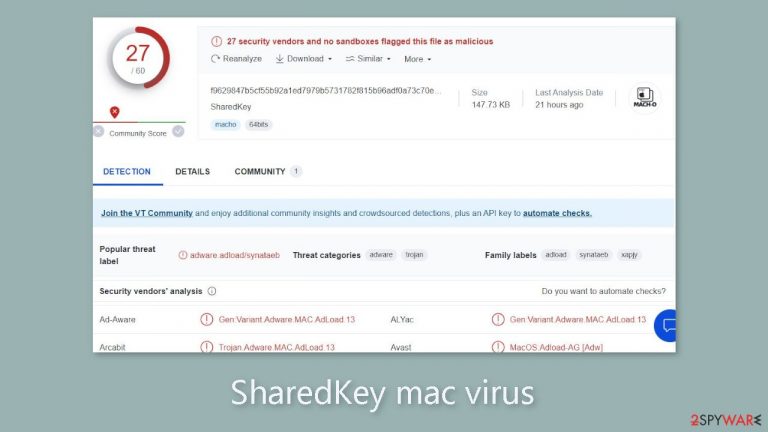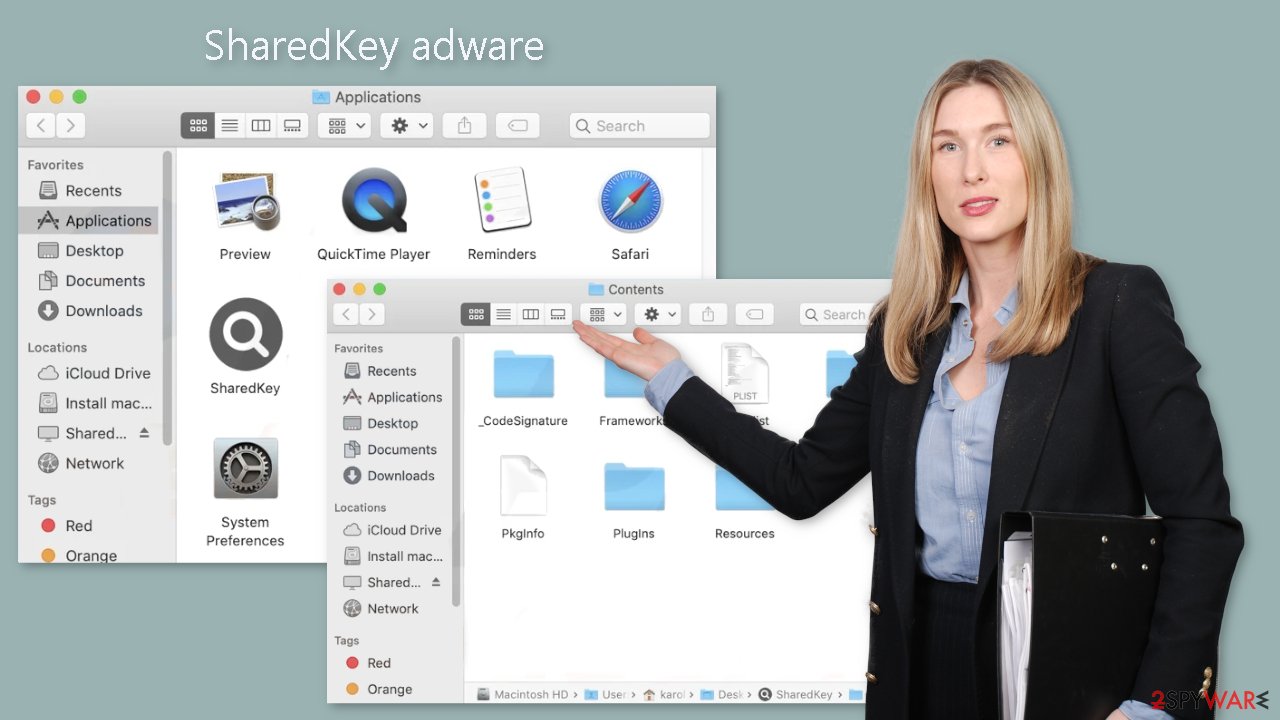SharedKey mac virus (Free Guide)
SharedKey mac virus Removal Guide
What is SharedKey mac virus?
SharedKey is a virus that targets Mac users and has adware and hijacking abilities

SharedKey is a malicious virus with both hijacking and adware capabilities. It is part of the Adload malware family and specifically targets Mac computers. Once infected, users are bombarded with obnoxious commercial content such as pop-ups, banners, and redirects. Furthermore, this virus has the ability to change important browser settings such as the homepage, new tab address, and search engine.
SharedKey's presence raises serious concerns about user privacy and security. Users are effectively forced to use only specific channels for browsing, limiting their freedom of choice. This virus's pop-up advertisements are frequently associated with untrustworthy advertising networks.
These advertisements may include links that take users to dangerous websites, exposing them to a variety of risks. Interacting with these ads frequently results in scam pages designed to trick people into disclosing personal information, downloading potentially unwanted programs (PUPs), or even installing malware.
Adload overview
Adware designed specifically to infect Mac machines is more aggressive than adware targeting Windows systems. The majority of users are unaware of its presence until it has already initiated changes, owing to its ability to evade detection by Apple's built-in security system, XProtect.[1] In previous discussions, we looked at a variety of other Adload malware variants, such as CommonHandler, LauncherLocator, and VirtualDetail.
These variants are strikingly similar, with an icon depicting a magnifying glass against a green, teal, or grey background. Furthermore, Mac viruses use a variety of evasion techniques to prevent easy removal. They frequently generate multiple files disguised as ordinary system files and disperse them throughout the machine. This deliberate scattering makes identification and elimination more difficult.
| NAME | SharedKey |
| TYPE | Adware, browser hijacker, mac virus |
| MALWARE FAMILY | Adload |
| SYMPTOMS | Different homepage and new tab addresses; redirects to a fake search engine and shady websites; performance issues; |
| DISTRIBUTION | Fake software updates, deceptive ads, peer-to-peer file-sharing platforms |
| DANGERS | Altered search results can lead to dangerous websites; pop-up ads might be promoting scams; the virus can install other PUPs or even malware in the background |
| ELIMINATION | Eliminating this Mac virus manually can be quite complicated because of various persistence techniques. The easiest and most effective way would be to open a professional security tool and scan your system to delete every related file |
| FURTHER STEPS | FortectIntego should be used to completely wipe out any data left and fix the remaining damage |
Distribution methods
Mac viruses, like other types of malware, are widely distributed via torrent[2] websites, peer-to-peer file-sharing platforms, and a variety of unauthorized websites. These platforms are unregulated, owing to the illegal distribution of “cracked” software. It is strongly advised to obtain software only from official web stores and developer websites to ensure a safer computing experience.
While it may incur some costs, maintaining a well-functioning system can result in long-term savings. Virus infections can cause system file corruption and other problems. Furthermore, a large number of free applications are available, allowing users to find suitable options that meet their needs.
Another possible scenario is becoming a victim of a bogus Flash Player update. Scammers build deceptive websites that trick users into thinking they need to update or install Flash Player. Despite the fact that Flash Player was decommissioned in 2020 and replaced by HTML5, many people are still unaware of this. As a result, if you come across such messages while browsing the web, it is critical that you disregard them.
Finally, it is critical to install updates for both your operating system and software on a regular basis to ensure the security of your system. Hackers frequently use software flaws to deliver malicious programs. Security patches are regularly released by software developers and should be applied as soon as they become available.

Removal of SharedKey mac virus
It is strongly advised that you do not attempt manual removal unless you have the necessary expertise and are familiar with the specific files that need to be deleted. Some of these files may have the .plist extension, which indicates a standard settings file, also known as a “properties file,” that macOS applications use. These files contain important program properties and configuration settings.
Furthermore, the malware employs multiple persistence techniques and disperses files throughout the system, making the removal of browser extensions and applications associated with it difficult. We strongly advise using professional anti-malware tools such as SpyHunter 5Combo Cleaner or Malwarebytes to ensure complete removal and peace of mind. These tools are specifically designed to detect and remove unwanted programs.
Furthermore, it is unknown whether the virus has installed additional malicious programs. As a result, relying on professional anti-malware tools is the most secure way to ensure that the system is thoroughly cleaned. If you must proceed with manual deletion, please follow the steps outlined below:
- Open Applications folder
- Select Utilities
- Double-click Activity Monitor
- Here, look for suspicious processes related to adware and use Force Quit command to shut them down
- Go back to the Applications folder
- Find SharedKey in the list and move it to Trash.
If you are unable to shut down the related processes or can't move the app to Trash, you should look for malicious profiles and login items:
- Go to Preferences and select Accounts
- Click Login items and delete everything suspicious
- Next, pick System Preferences > Users & Groups
- Find Profiles and remove unwanted profiles from the list.
There are likely to be more .plist files hiding in the following locations – delete them all:
- Select Go > Go to Folder.
- Enter /Library/Application Support and click Go or press Enter.
- In the Application Support folder, look for any dubious entries and then delete them.
- Now enter /Library/LaunchAgents and /Library/LaunchDaemons folders the same way and terminate all the related .plist files.

The manual elimination process might not always result in full virus removal. Therefore, we still strongly suggest you perform a scan with security software.
Remove the browser hijacker
SharedKey also installs a browser extension that performs a variety of unwanted actions. It is capable of collecting sensitive data and transmitting it to tracking servers. IP address, user name, macOS version, browser versions, computer ID, items in the “Applications” folder, and a list of agents, daemons, and system configuration profiles may be exposed.
Once the malicious files have been removed from your system, you must remove the browser add-on as soon as possible. You can speed up the process by using FortectIntego, which automatically deletes cookies[3] and cache while also repairing any damaged files and resolving any system errors. This should result in an improvement in the performance of your machine.
If you prefer to tackle the removal process independently without additional assistance, please refer to the instructions provided below. At the bottom of this article, you will find detailed guides for removing the add-on from both Google Chrome and Mozilla Firefox:
- Click Safari > Preferences…
- In the new window, pick Extensions.
- Select the unwanted extension and select Uninstall.

Cookies and website data:
- Click Safari > Clear History…
- From the drop-down menu under Clear, pick all history.
- Confirm with Clear History.

The simplest and quickest solution to this is completely resetting Safari:
- Click Safari > Preferences…
- Go to Advanced tab.
- Tick the Show Develop menu in menu bar.
- From the menu bar, click Develop, and then select Empty Caches.

Getting rid of SharedKey mac virus. Follow these steps
Remove from Mozilla Firefox (FF)
Remove dangerous extensions:
- Open Mozilla Firefox browser and click on the Menu (three horizontal lines at the top-right of the window).
- Select Add-ons.
- In here, select unwanted plugin and click Remove.

Reset the homepage:
- Click three horizontal lines at the top right corner to open the menu.
- Choose Options.
- Under Home options, enter your preferred site that will open every time you newly open the Mozilla Firefox.
Clear cookies and site data:
- Click Menu and pick Settings.
- Go to Privacy & Security section.
- Scroll down to locate Cookies and Site Data.
- Click on Clear Data…
- Select Cookies and Site Data, as well as Cached Web Content and press Clear.

Reset Mozilla Firefox
If clearing the browser as explained above did not help, reset Mozilla Firefox:
- Open Mozilla Firefox browser and click the Menu.
- Go to Help and then choose Troubleshooting Information.

- Under Give Firefox a tune up section, click on Refresh Firefox…
- Once the pop-up shows up, confirm the action by pressing on Refresh Firefox.

Remove from Google Chrome
Delete malicious extensions from Google Chrome:
- Open Google Chrome, click on the Menu (three vertical dots at the top-right corner) and select More tools > Extensions.
- In the newly opened window, you will see all the installed extensions. Uninstall all the suspicious plugins that might be related to the unwanted program by clicking Remove.

Clear cache and web data from Chrome:
- Click on Menu and pick Settings.
- Under Privacy and security, select Clear browsing data.
- Select Browsing history, Cookies and other site data, as well as Cached images and files.
- Click Clear data.

Change your homepage:
- Click menu and choose Settings.
- Look for a suspicious site in the On startup section.
- Click on Open a specific or set of pages and click on three dots to find the Remove option.
Reset Google Chrome:
If the previous methods did not help you, reset Google Chrome to eliminate all the unwanted components:
- Click on Menu and select Settings.
- In the Settings, scroll down and click Advanced.
- Scroll down and locate Reset and clean up section.
- Now click Restore settings to their original defaults.
- Confirm with Reset settings.

How to prevent from getting adware
Do not let government spy on you
The government has many issues in regards to tracking users' data and spying on citizens, so you should take this into consideration and learn more about shady information gathering practices. Avoid any unwanted government tracking or spying by going totally anonymous on the internet.
You can choose a different location when you go online and access any material you want without particular content restrictions. You can easily enjoy internet connection without any risks of being hacked by using Private Internet Access VPN.
Control the information that can be accessed by government any other unwanted party and surf online without being spied on. Even if you are not involved in illegal activities or trust your selection of services, platforms, be suspicious for your own security and take precautionary measures by using the VPN service.
Backup files for the later use, in case of the malware attack
Computer users can suffer from data losses due to cyber infections or their own faulty doings. Ransomware can encrypt and hold files hostage, while unforeseen power cuts might cause a loss of important documents. If you have proper up-to-date backups, you can easily recover after such an incident and get back to work. It is also equally important to update backups on a regular basis so that the newest information remains intact – you can set this process to be performed automatically.
When you have the previous version of every important document or project you can avoid frustration and breakdowns. It comes in handy when malware strikes out of nowhere. Use Data Recovery Pro for the data restoration process.
- ^ Protecting against malware in macOS. Apple. Platform Security.
- ^ Brad Haddin. 4 risks of using torrents. Creative. Apps, Gadgets, Opinion, Tech.
- ^ What are Cookies?. Kaspersky. Home Security.
